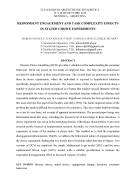Por favor, use este identificador para citar o enlazar este ítem:
https://repositorio.uca.edu.ar/handle/123456789/5612| Título: | Respondent engagement and task complexity effects in stated choice experiments | Autor: | Bonoli Escobar, Mariano Volpe, Juan Ignacio Mosca, Johana Picasso, Emilio |
Otros colaboradores: | Sociedad Argentina de Estadística | Palabras clave: | INGENIERIA; COMPORTAMIENTO; METODOS DE ESTUDIO; ESTADISTICA; CONSUMIDORES | Fecha de publicación: | 2013 | Cita: | Bonoli Escobar, M., Volpe, J.I., Mosca, J., Picasso, E. Respondet engagement and task complexity effects in stated choice experiments [en línea]. En: XLI Coloquio Argentino de Estadística; 2013 Oct 15-18; Mendoza : Sociedad Argentina de Estadística. Disponible en: https://repositorio.uca.edu.ar/handle/123456789/5612 | Resumen: | Abstract: Discrete Choice Modelling (DCM) provides a valuable tool for understanding the consumer behaviour. DCM can source on two kinds of empirical base. The first one are preferences revealed by individuals in their actual behaviour. The second kind are preferences stated by them in choice experiments, where the individual is exposed to hypothetical situations specifically designed to elicit decisions. The repeat nature of the choice experiment along a number of choice sets has been recognized as a feature that requires special attention, with the focus primarily on ways of accounting for the correlated structure induced by offering each respondent multiple choice sets in a sequence. Significant research has been produced about this issue after the first paper from Bradley and Daly (1994). The harsh empirical nature of the problem has made it difficult for researchers to be conclusive. They have rather built knowledge on a case by case basis, not exempt of apparent inconsistencies. The present paper brings new information about this issue, extending the present level of knowledge in three directions. A choice experiment was set up in the marketing domain, with unique characteristics vs previous research mostly focused on transportation research. Secondly, we went beyond most previous experience in terms of the number of choice tasks. This enabled us to find the respondent disengagement phenomenon. Thirdly, we address the behavioural nature of engagement along the choice experiment, finding that it is mostly due to boredom rather than due to fatigue. Two versions of DCM are employed: the simple Multinomial Logit model (MNL) and the more sophisticated Mixed Logit (MXL) model, with a suitable specification to measure the respondent disengagement effect as increased variance of utility. | URI: | https://repositorio.uca.edu.ar/handle/123456789/5612 | Disciplina: | INGENIERIA | Derechos: | Acceso Abierto | Fuente: | Coloquio Argentino de Estadística (41º : 2013 : Mendoza, Argentina) |
| Aparece en las colecciones: | Ponencias |
Ficheros en este ítem:
| Fichero | Descripción | Tamaño | Formato | |
|---|---|---|---|---|
| respondet-engagement-task-effects.pdf | 341,89 kB | Adobe PDF |  Visualizar/Abrir |
Visualizaciones de página(s)
155
comprobado en 30-abr-2024
Descarga(s)
62
comprobado en 30-abr-2024
Google ScholarTM
Ver en Google Scholar
Este ítem está sujeto a una Licencia Creative Commons

